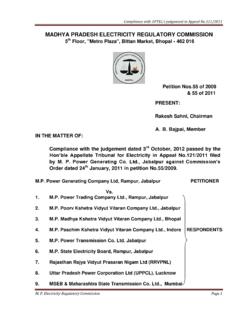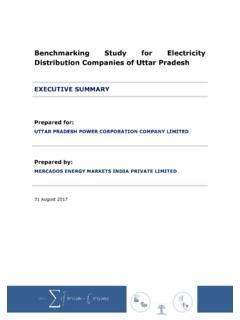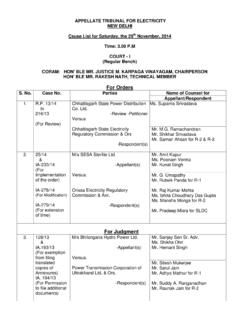Transcription of Central Electricity Regulatory Commission New Delhi
1 Central Electricity Regulatory Commission Central Electricity Regulatory Commission New Delhi Staff Paper on Introduction of Electricity Storage System in India January 2017. Staff Paper on Electricity Storage Services, 2017. Central Electricity Regulatory Commission Index Sl. No. M ain Titles/ Sub Titles Page No. 1. Introduction 1. 2. Overview of Storage Technology 9. 3. Grid Level Applications of Electricity Storage System 11. Optimization of Generation 11. Controlling Intermittent Generation from Renewable Sources 11. Reliable Operation of Power System Operation 11. Minimize the deviation from schedule dispatch or drawl 12. Storage of Excess Generation of Grid 12. Ancillary Service 13. 4. Potential Owners of Electricity Storage Facilities 13. Transmission licensees 13. Generating Companies 13. Distribution Licensees 14. Merchant power plant (including Captive Power Plant) 14. Bulk Consumers 14. 5. Operational Framework 15.
2 Multiple Uses 15. Multiple Ownership 18. Probable Operational Framework 19. Combine with generating station 20. Combine with transmission business 21. 6. Recovery of Electricity Storage Services 22. Recovery of Electricity Storage Services for dedicated use 22. In case of conventional generating station 23. In case of renewable generating station 25. Non-dedicated use of the ESS 26. -Generation shift 26. -Controlling intermittent nature of renewable Generation 27. -Voltage Control or Congestion Purpose 27. -Deviation Control 28. -Balancing Control or storage of excess generation 28. Open Access to the Inter-State Transmission 29. 7. Regulatory Jurisdiction 30. 8. Challenges to the deployment of Energy Storage System 33. Cost competitive energy storage technologies 33. Environment issues of storage technologies 34. Policy framework for storage technologies 34. Safety aspects of battery storage technologies 34. Stakeholder's Acceptance of technology and cost 35.
3 9. Comments from the stakeholders- issues to be addressed 35. 10. Appendix 38. Staff Paper on Electricity Storage Services, 2017. Central Electricity Regulatory Commission Introduction The electrical generators connected to the grid and supplying Electricity are categorised based on their operating cost/ pattern of base load, peak load and intermediate load. The Electricity demand fluctuates throughout the day. The hydroelectric generating stations with un-priced fuel are traditionally used to meet the peak load or intermediate load; however, most of the time, it is not adequate to meet the gap of peak demand. The peaking generating stations1, with high variable cost, are intended to bridge the gap between peak and base load. These generating stations are capable to start and stop quickly and operate when high ramping rate is required . The precise balancing of Electricity demand and generation is achieved by adjusting output of generating stations such as hydroelectric and gas based generating stations.
4 These generating stations are also called as load following generating stations. The use of gas based generating stations for balancing purpose is uneconomical as it increases the power purchase cost of distribution licensees due to higher price of natural gas in India. The increasing share of renewable generations in the grid has impacted the traditional approach of balancing. The renewable sources with un-priced 1. Gas based generating plants are considered as peaking plants in this paper, provides quick start and stop, to meet the demand variation. These stations are uneconomical due to high gas price compared to coal. Staff Paper on Electricity Storage Services, 2017 1. Central Electricity Regulatory Commission fuel such as Wind, Solar Power are intermittent in nature, that is, their output depends on external conditions, such as sunshine or wind. The value and timing of their output are not controllable. The variability of renewable generation is to be taken into account while adjusting output of load following generating stations for the purpose of balancing.
5 One of the approaches to address the variability of renewable generation is capacity addition of conventional load following generating stations such as hydro electric plants and gas based plants. The use of load following generating stations is not limited to variation of load, but its use is now extended to counter the variability of renewable generation. The higher penetration of renewable generation will require higher capacity of load following generating stations. The balancing through the conventional load following generating stations such as hydroelectric plant and gas based thermal plant would not be adequate. Alternatively, the renewable generation dominated states use coal based thermal generating stations to counter balance the variability of the renewable generation. However, regulating generation output2 of coal based thermal generation plants, to address the variability of renewable generation is not recommended based on number of consideration including uneconomical cost and challenges involved in practical implementation.
6 2. Generation output refers the ex-bus generation of the grid connected conventional generating station which is being regulated for balancing the variability of renewable generation . Staff Paper on Electricity Storage Services, 2017 2. Central Electricity Regulatory Commission The decentralized market structure provides individual market entities to be more responsive in complying with grid discipline rules of balancing their generation and demand. The Commission has mandated volume limits on over- drawal and under-drawal of Electricity by any beneficiary or a buyer and under- injection or over-injection of Electricity by a generating station or a seller in order to maintain grid frequency between Hz and Hz. Load serving entities are severely affected due to these grid discipline rules because of variation of flow over the periphery on account of uncontrolled fluctuation of load. Further, the intermittent nature of renewable generation within the periphery of load serving entities will further contribute to variation of power flow over the periphery.
7 In the coming decade, the need for modernizing the grid will help the nation to meet the challenge of handling projected energy needs as well as increasing energy from renewable sources while maintaining a robust and resilient Electricity delivery system. These challenges warrant a specific energy storage solution to cater to peak demand and to address the variability of intermittent generation. In this context, need is felt for specific Electricity Storage System ( the ESS ) that would provide economically feasible Electricity Storage Services to address these challenges. Energy storage can play a significant role in meeting these challenges by improving the operating capabilities of the grid, lowering power purchase cost and ensuring high reliability by maintaining unscheduled interchange as well as deferring and Staff Paper on Electricity Storage Services, 2017 3. Central Electricity Regulatory Commission reducing infrastructure investments in new projects.
8 The ESS has a wide range of applications which can be deployed from consumer level, connected to distribution system, to bulk storage system connected to the grid. The ESS in India has long term economic significance. The ESS has a potential to improve industry economics because it connects diverse energy sources to diverse energy uses. It enables some portion of one time s consumptive load to be met from another time s primary generation. The most common form of grid energy storage in the India is pump- storage hydroelectricity, in which electrical energy is converted to gravitational potential energy, which is subsequently converted back to Electricity by running the water down through a turbine. Pump-storage hydroelectric plants represent about GW capacity (under operation and construction) storage capacity and is one of the mature technologies for the bulk Electricity storage, However, it s yet to carve a niche for itself in the overall basket of about 309 GW installed capacity as on date in the country.
9 Therefore relying only on the traditional approach for storing Electricity through a pump-storage hydroelectric plant would not be adequate and thus, unconventional bulk Electricity storage system (ESS) would be required. The bulk ESS is specifically useful to address controlling of renewable generation. In India, Renewable potential is concentrated in a few States such as Tamil Nadu, Rajasthan, Gujarat etc. In these States, further growth of renewable generation has been limited due to intermittent nature of these Staff Paper on Electricity Storage Services, 2017 4. Central Electricity Regulatory Commission sources. The renewable dominated States are facing specific challenges for maintaining reliability. The ESS can play a vital role in addressing these challenges in renewable dominated States. The application of the ESS is envisaged for the renewable dominated States for time shifting of the renewable generation, optimal utilization of the available generation, shifting of generation at the time when it is required and utilization of the renewable generator for longer period.
10 Although, the ESS may initially have various challenges including cost/. commercial reasons, but in the long run, cost of the ESS is expected to decrease due to technological innovations. In this context, it is to be noted that the State of California, USA enacted a Law3 in October, 2010 requiring the California Public Utilities Commission (CPUC) to establish appropriate energy storage procurement targets for California load serving entities for 2015 and 2020, if cost effective and commercially viable by October, 2013. In June 2013, the CPUC proposed storage procurement targets and mechanisms totaling 1,325 MW of storage which indicates the possible viability in storage technologies. Also to be noted is the Enhanced Frequency Auction results (200. MW of frequency response capacity) starting as early as April 2017 in National 3. California Governor signed a landmark legislation (first laws on energy storage systems in USA) designed to increase the use of large-scale energy storage systems.














